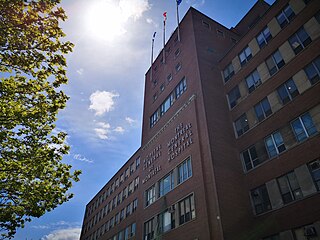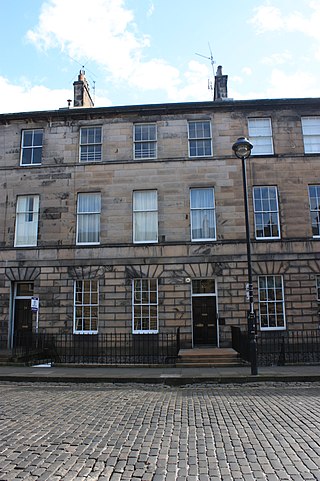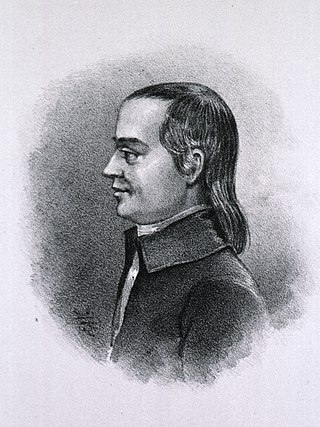
Charles Bulfinch was an early American architect, and has been regarded by many as the first American-born professional architect to practice.

The Tufts University School of Medicine is the medical school of Tufts University, a private research university in Massachusetts. It was established in 1893 and is located on the university's health sciences campus in downtown Boston. It has clinical affiliations with numerous doctors and researchers in the United States and around the world, as well as with its affiliated hospitals in both Massachusetts, and Maine.

Harrison Gray Otis, was a businessman, lawyer, and politician, becoming one of the most important leaders of the United States' first political party, the Federalists. He was a member of the Otis family.
Tufts University School of Dental Medicine (TUSDM) is a private, American dental school located in the Chinatown neighborhood of Boston, Massachusetts, and is connected to Tufts Medical Center. It is one of the 8 graduate schools that comprise Tufts University. Founded in 1868 as Boston Dental College by Dr. Isaac J. Wetherbee, the university is the second oldest dental school in the city, and one of the oldest in the country.

The Ancoats Hospital and Ardwick and Ancoats Dispensary was a large inner-city hospital located in Ancoats, to the north of the city centre of Manchester, England. It was built in 1875, replacing the Ardwick and Ancoats Dispensary that had existed since 1828. The building is now Grade II listed.

The Montreal General Hospital (MGH) is a hospital in Montreal, Quebec, Canada established in the years 1818–1820. The hospital received its charter in 1823. It is currently part of the McGill University Health Centre (MUHC) and is located on Mount Royal, at the intersection of Pine Avenue and Côte-des-Neiges Road. It has six pavilions: A, B, C, D, E and Livingston (L); plus a research centre in a separate building next to the L pavilion.

Samuel Abbott Green was an American physician-turned-politician from Massachusetts who served as a medical officer during the American Civil War and as mayor of Boston in 1882. He was an elected member of the American Philosophical Society.

The Old Corner Bookstore is a historic commercial building located at 283 Washington Street at the corner of School Street in the historic core of Boston, Massachusetts. It was built in 1718 as a residence and apothecary shop, and first became a bookstore in 1828. The building is a designated site on Boston's Freedom Trail, Literary Trail, and Women's Heritage Trail.
CHA Everett Hospital is a 162-bed medical/surgical and psychiatric hospital in Everett, Massachusetts. It is one of three hospitals in Cambridge Health Alliance.

Tufts Medical Center, a 15-building campus located in Boston, Massachusetts, is a downtown Boston hospital midway between Chinatown and the Boston Theater District.

The Quincy family was a prominent political family in Massachusetts from the mid-17th century through to the early 20th century. It is connected to the Adams political family through Abigail Adams.

Annin & Smith was an engraving firm in Boston, Massachusetts, in the 19th century, established by William B. Annin and George Girdler Smith. The firm kept offices on Court Street and Cornhill.
The Boston Female Asylum (1803–1910) was an orphanage in Boston, Massachusetts, US "for the care of indigent girls." Its mission was to "receive ... protect ... and instruct ... female orphans until the age of 10 years, when they are placed in respectable families."

Thomas Melvill or Thomas Melville was a merchant, member of the Sons of Liberty, participant in the Boston Tea Party, a major in the American Revolutionary War, a longtime fireman in the Boston Fire Department, state legislator, and paternal grandfather of writer Herman Melville.

William Beilby FRCPE was a British philanthropic physician in Edinburgh.
Munroe & Francis was a publishing firm in Boston, Massachusetts, in the early 19th-century. Established by David Francis (1779–1853) and Edmund Monroe, the business operated from offices on Court Street and Washington Street. In the 19th century the firm expanded to include Samuel H. Parker as partner, and was called Munroe, Francis & Parker until 1810. In 1802–1804 Munroe & Francis issued the first Boston edition of William Shakespeare's works.

Samuel Powel Griffitts was an American physician, widely regarded as the founder, in 1786, of the Philadelphia Dispensary. He was an early member of the American Philosophical Society, elected in 1785.


















